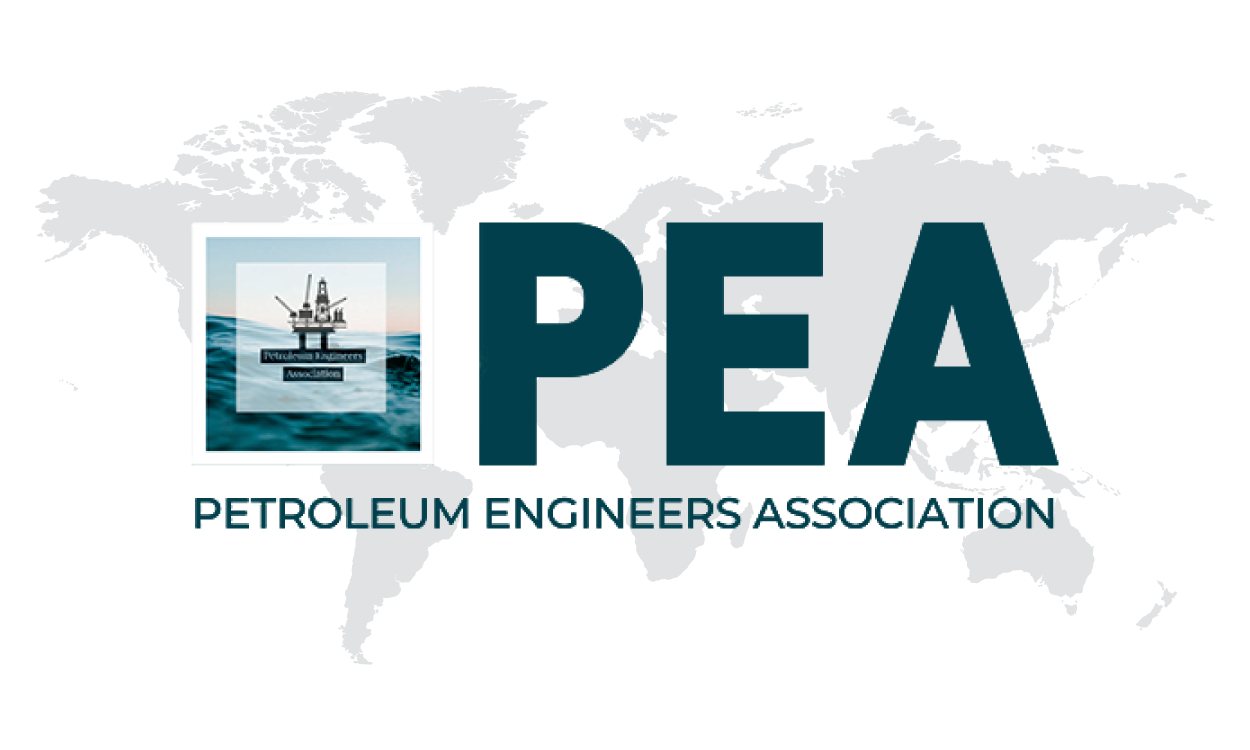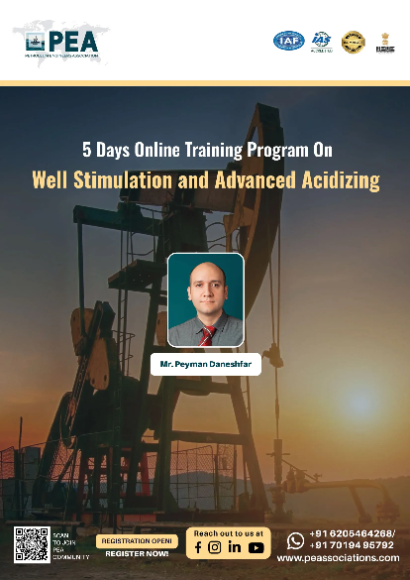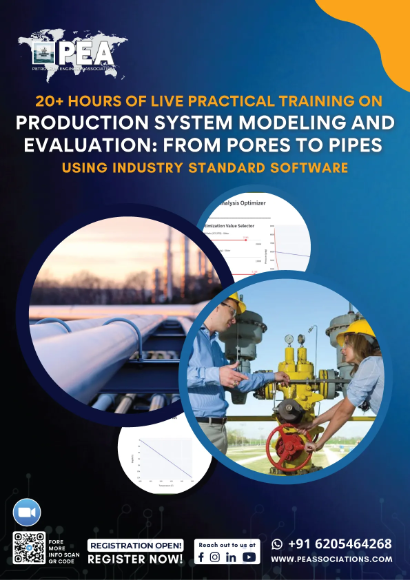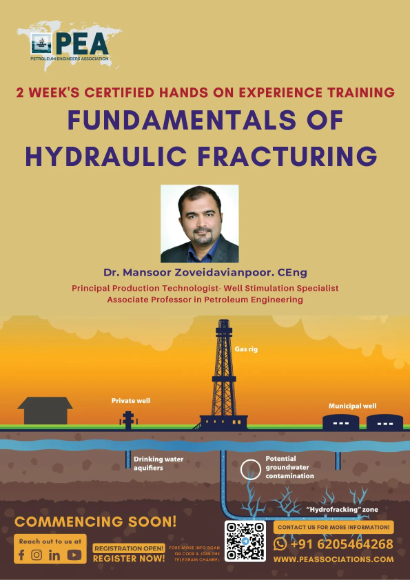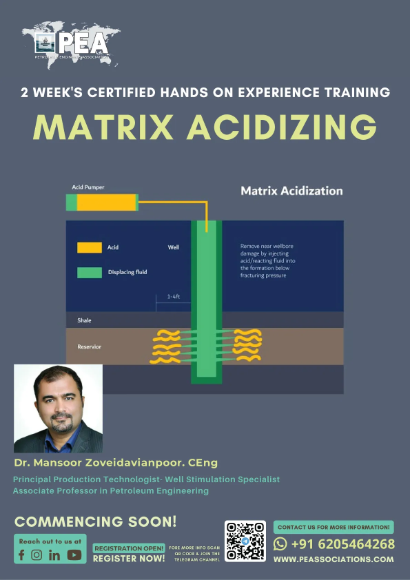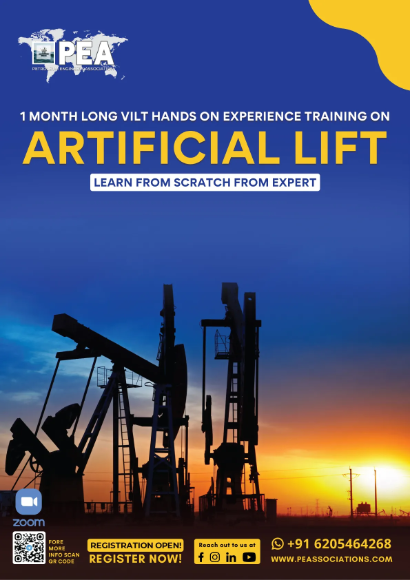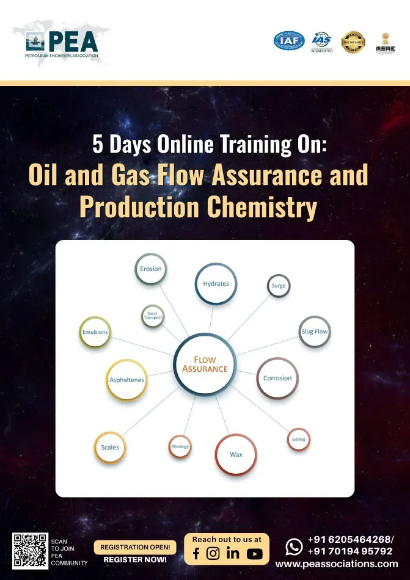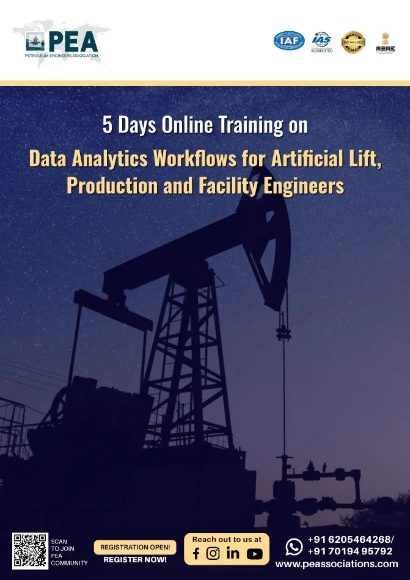Well Stimulation and Advanced Acidizing
| Code | Date | Time | Duration | Location | Currency | Team of 10 Per Person | Team of 7 Per Person | Early Bird Fee Per Person | Normal Fee Per Person |
|---|---|---|---|---|---|---|---|---|---|
| WSA26 | 16 - 20 Mar 2026 | 7 PM Indian Time |
4 Hours Per Day
|
Zoom Online
|
USD
|
1500
|
1850
|
2000
|
2500
|
The Classes Will be from Monday to Friday Via Zoom Online.
Boost your team's skills and your budget! Enjoy group discounts for collaborative learning. Send an inquiry to info@peassociations.com.
Well Stimulation and Advanced Acidizing
This course provides in-depth knowledge on well stimulation techniques, focusing on advanced acidizing processes to maximize reservoir productivity. Learn industry best practices, innovative methodologies, and strategies for enhancing well performance and recovery rates.
Description
The "Well Stimulation and Advanced Acidizing" course is designed to equip participants with comprehensive knowledge and practical skills in well stimulation techniques, specifically focusing on acidizing methods. The course covers the principles of formation damage, acid types, and treatment design to optimize well productivity and reservoir performance. Participants will explore advanced techniques and the latest developments in acidizing to ensure enhanced hydrocarbon flow and improved operational efficiency.
Demo Class
Oil and gas wells differ widely in terms of geological setting (e.g., carbonate vs. sandstone formations), reservoir properties, production history, and the nature of formation damage. As such, selecting the most appropriate stimulation method is essential to enhance, or in some cases maintain, well productivity.
This specialized training program provides a comprehensive understanding of well stimulation techniques, with a primary focus on scale removal and acidizing operations and also fundamental of Hydraulic Fracturing. The course bridges fundamental concepts with practical applications and advanced job design methodology.
Participants will be actively engaged in the design of stimulation treatments based on real-world well data, working collaboratively to develop effective treatment plans. Simulation exercises using STIMPRO™ software offer hands-on experience in modeling acidizing jobs and evaluating treatment performance.
Key features of the course include:
- In-depth exploration of formation damage mechanisms and stimulation strategies
- Practical exposure to acidizing design procedures tailored for both carbonate and sandstone reservoirs
- Integration of field case studies, interactive discussions, and simulation tools
- Delivery through a blended format of technical lectures, videos, animations, and job examples
- Structured assessments to benchmark participants’ baseline knowledge and measure learning outcomes throughout the course
By the end of this course, participants will be equipped with the technical knowledge and practical skills needed to design, evaluate, and optimize well stimulation treatments with confidence and efficiency in real field scenarios.
This course is designed to equip participants with both the theoretical foundations and practical skills necessary to understand, plan, and execute effective well stimulation treatments. By the end of the program, participants will be able to:
- Understand geological and reservoir fundamentals relevant to stimulation, including key properties of carbonate and sandstone formations.
- Identify the concept, causes, and mechanisms of formation damage, and evaluate its impact—particularly the role of skin factor—on well productivity
- Gain a comprehensive overview of well stimulation techniques, including:
o Scale removal methods
o Matrix acidizing processes
o Basic principles of acid and hydraulic fracturing
- Recognize stimulation fluid types, and understand the criteria for candidate well selection.
- Develop competency in planning, designing, executing, and monitoring stimulation jobs, incorporating field data and operational constraints.
- Learn about acid systems and additives, including:
o Types of acids (e.g., HCl, HF blends)
o Common additives and diverter agents
- Application strategies and performance evaluation
- Understand the function and application of Preflush and Overflush fluids, including their design limitations and operational performance.
- Become familiar with laboratory testing methods used in acidizing design, such as: Compatibility tests, Sludge and emulsion tests, Corrosion and diverting efficiency tests
- Get introduced to the field equipment used in stimulation operations, including:
o Coiled tubing systems and their role in acidizing
o Stimulation vessels and offshore stimulation workflows
- Explore emerging technologies in stimulation and Enhanced Oil Recovery (EOR)
- Gain hands-on training in STIMPRO™ software, including (Simulation and treatment optimization): Data input for well-specific scenarios.
The course will use a blend of lectures, case studies, practical exercises, and interactive discussions. Participants will engage in hands-on activities and real-world simulations to reinforce learning and develop problem-solving skills relevant to well stimulation and acidizing processes.
Improved well performance and productivity.
Enhanced understanding of the latest well stimulation and acidizing techniques.
Reduction in operational costs through effective treatment design.
Increased ability to handle complex well stimulation challenges.
Boosted technical skills of team members, leading to more efficient operations.
Participants gain:
In-depth understanding of formation damage and stimulation strategies.
Practical skills in acidizing design for carbonate and sandstone reservoirs.
Exposure to real-world case studies, interactive discussions, and simulation tools.
Structured assessments to measure progress.
Ability to confidently design, evaluate, and optimize stimulation treatments.
Solid foundation in acidizing and scale removal techniques.
Insights into wellbore treatment methods aimed at restoring reservoir flow.
Foundational knowledge of hydraulic fracturing principles.
Hands-on usage of STIMPRO™ software for acid job modeling.
Emphasis on health, safety, and environmental practices in acid handling.
The course is valuable for:
Well Stimulation and Intervention Engineers.
Field Engineers, Technical Engineers, Laboratory Engineers, Service Supervisors in acidizing and stimulation.
Well Completion Engineers, Team Leaders, and Managers.
Drilling Engineers and Managers.
Production Engineers, Workover Engineers, and Well Intervention Technologists.
Petroleum and Reservoir Engineers focused on formation damage.
Senior petroleum engineering students seeking industry-relevant knowledge.
Day 1
Welcome
Welcome & Introduction
1st Day Quiz, Opening Quiz – Assessing Baseline Knowledge
Geological Framework & Fundamental Reservoir Properties
Understanding Formation Damage: Concepts, Causes, and the Role of Skin Factor
Overview of Well Stimulation: Objectives and Mechanisms
Well Stimulation Techniques: Methods and Applications
Candidate Selection for Stimulation Treatments
Scale Deposition: Causes, Types, and Impact on Production
Scale Removal Procedures: Techniques and Field Practices
Day 2
Introduction to Acidizing: Purpose and Principles
Fundamental Definitions: Acids, Bases, and Salts
Types of Acidizing Treatments:
Acid Wash
Matrix Acidizing
Fracture Acidizing
Sandstone Acidizing Principle
Carbonate Acidizing Principle
Diversion Techniques: Definitions, Applications, and Effectiveness
Introduction to Coiled Tubing:
Basic Principles and Capabilities
Coiled Tubing in Acidizing Operations
Day 3
Acidizing Formation Damages
Overview of Acidizing Additives:
Types, Functions, and Selection Criteria
Laboratory Testing of Acids and Additives:
Objectives, Procedures, and Interpretation of Results
Fluids in Acidizing Operations:
Pickling, Preflush, and Overflush – Definitions and Roles
Comprehensive Acidizing Calculations:
Acid Or Fluid Volume, Injection Pressure, Rate, and Key Design Parameters in :
Carbonate Reservoirs
Sandstone Reservoirs
Carbonate Acidizing Wormhole Structures
Day 4
Introduction to Geomechanical Parameters
Fundamentals of Hydraulic Fracturing:
Objectives of Hydraulic Fracturing
Enhancing reservoir contact and production
Standard Job Procedure
Fracture Orientation and Propagation Direction
Role of stress contrast and natural fractures
Fracture Geometry Models
PKN, KGD, radial and 3D models – concepts and applications
Fracture Conductivity
Importance, influencing factors, and optimization strategies
Fracturing Fluids and Additives
Types (gelled, slickwater, crosslinked, etc.)
Selection criteria and additive roles (gelling agents, breakers, friction reducers, etc.)
Proppant Selection and Characteristics
Types (sand, resin-coated, ceramics)
Size, strength, and conductivity trade-offs
MiniFrac (Data Frac) Test
Purpose, methodology, and interpretation for main job design
Hydraulic Fracturing Design Workflow
Step-by-step procedure
Key design calculations (fluid volume, rate, pressure, proppant schedule, etc.)
Fracture Acidizing:
Concept, Design Considerations, and Operational Strategies
Acidizing Job Evaluations
Day 5
Introduction to Stimulation Equipment for Onshore & Offshore Operations
Basic Principles of Stimulation Vessel Operations
Overview of Modern Stimulation and EOR Technologies
Designing Practical Acidizing Jobs Based on Real Well Data
Case studies and participant-led design exercises
STIMPRO Software – Practical Simulation Sessions
Hands-on training using actual well input data
Performing job simulations and interpreting results
Final Quiz – Course Wrap-Up Assessment
Evaluating knowledge gained throughout the training
Q&A / Feedback Session
Open discussion, experience sharing, and participant feedback
On successful completion of this training course, PEA Certificate will be awarded to the delegates

Frequently Asked Questions
All course bookings made through PEA are strictly non-refundable. By registering for a course, you acknowledge and accept that all fees are payable in full and are not subject to refund under any circumstances, including changes in personal or professional commitments or partial attendance.
PEA reserves the right to make reasonable adjustments to course content, trainers, or schedules where necessary, without entitling delegates to a refund. Comprehensive details of each course — including objectives, target audience, and content — are clearly outlined before enrolment, and it is the responsibility of the delegate to ensure the course's suitability prior to booking.
For any inquiries related to cancellations or bookings, please contact our support team, who will be happy to assist you.

